Italian resistance movement
| Italian resistance | |
|---|---|
| Resistenza italiana(Italian) | |
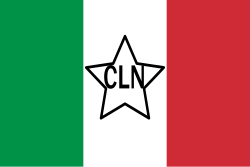  Flag of theNational Liberation Committeeand some members of the Italian resistance inOssola,1944 | |
| Leaders | |
| Dates of operation | 8 September 1943 – 25 April 1945 |
| Motives | Liberation of Italy from Nazism and Fascism |
| Headquarters | Rome |
| Active regions | Kingdom of Italy |
| Ideology | |
| Allies | Kingdom of Italy Allies |
| Opponents | Nazi Germany Italian Social Republic |
| Battles and wars | theItalian campaignofWorld War II;involvement of Italian army and partisan units in Yugoslavia, Greece, Albania, and France. |
TheItalian Resistance(Italian:Resistenza italiana,pronounced[reziˈstɛntsaitaˈljaːna],or simplyLaResistenza) consisted of all theItalianresistance groupswho fought the occupying forces ofNazi Germanyand the fascist collaborationists of theItalian Social Republicduring theSecond World WarinItalyfrom 1943 to 1945. As a diverseanti-fascistand anti-nazist movement and organisation, theResistenzaopposed Nazi Germany and its Fascistpuppet stateregime, the Italian Social Republic, which the Germans created following the Nazi German invasion andmilitary occupationof Italy by theWehrmachtand theWaffen-SSfrom 8 September 1943 until 25 April 1945.
General underground Italian opposition to theFascist Italian governmentexisted even before World War II, but open and armed resistance followed the German invasion of Italy on 8 September 1943: in Nazi-occupied Italy, the Italian Resistance fighters, known as thepartigiani(partisans), fought aguerra di liberazione nazionale('national liberation war') against the invading German forces; in this context, the anti-fascistpartigianiof the Italian Resistance also simultaneously participated in theItalian Civil War,fighting against theItalian Fascistsof the collaborationistItalian Social Republic.
The Resistance was a diverse coalition of various Italian political parties, independent resistance fighters and soldiers, andpartisan brigades and militias.The modernItalian Republicwas declared to be founded on the struggle of the Resistance: theConstituent Assemblywas mostly composed of representatives of the parties that had given life to the Italian Resistance'sNational Liberation Committee.These former Italian Resistance fighters wrote theConstitution of Italyat the end of the war based on a compromissory synthesis of their Resistance parties' respective principles ofdemocracyandanti-fascism.[1]
Background[edit]
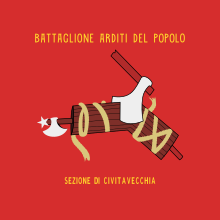
The Italian Resistance has its roots inanti-fascism,which progressively developed in the period from the mid-1920s, when weak forms of opposition to thefascist regimealready existed, until the beginning ofWorld War II.Furthermore, in the memory of the partisan fighters, especially those of communist and socialist inspiration, the memory of theBiennio Rossoand of the violent struggles against thefascist squadsin the period 1919–1922, considered by some exponents of the left-wing parties (among whichPalmiro Togliattihimself) a true "civil war" in defence of the popular classes against the reactionary forces.[2]

In Italy, Mussolini'sFascistregime used the termanti-fascistto describe its opponents. Mussolini'ssecret policewas officially known as theOrganization for Vigilance and Repression of Anti-Fascism.During the 1920s in theKingdom of Italy,anti-fascists, many of them from thelabor movement,fought against the violentBlackshirtsand against the rise of the fascist leader Benito Mussolini. After theItalian Socialist Party(PSI) signed apacification pactwith Mussolini and hisFasces of Combaton 3 August 1921,[3]and trade unions adopted a legalist and pacified strategy, members of the workers' movement who disagreed with this strategy formedArditi del Popolo.[4]
TheItalian General Confederation of Labour(CGL) and the PSI refused to officially recognize the anti-fascist militia and maintained a non-violent, legalist strategy, while theCommunist Party of Italy(PCd'I) ordered its members to quit the organization. The PCd'I organized some militant groups, but their actions were relatively minor.[5]The Italian anarchistSeverino Di Giovanni,who exiled himself to Argentina following the 1922March on Rome,organized several bombings against the Italian fascist community.[6]The Italian liberal anti-fascistBenedetto Crocewrote hisManifesto of the Anti-Fascist Intellectuals,which was published in 1925.[7]Other notable Italian liberal anti-fascists around that time werePiero GobettiandCarlo Rosselli.[8]

After the murder of the socialist deputyGiacomo Matteotti(1924) and the decisive assumption of responsibility by Mussolini, the process oftotalitarianizationof the State began in theKingdom of Italy,which will give rise to ever greater control and severe persecution of opponents, at risk of imprisonment and confinement.
The anti-fascists therefore organized themselves clandestinely in Italy and abroad, creating with great difficulty a rudimentary network of connections, which however did not produce significant practical results, remaining fragmented into small uncoordinated groups, incapable of attacking or threatening the regime, if some attacks carried out in particular by anarchists are excluded. Their activity was limited to the ideological side; the production of writings was copious, particularly among the anti-fascist exile communities, which however did not reach the masses and did not influence public opinion.[9]
Concentrazione Antifascista Italiana(English:Italian Anti-Fascist Concentration), officially known as Concentrazione d'Azione Antifascista (Anti-Fascist Action Concentration), was an Italian coalition of Anti-Fascist groups which existed from 1927 to 1934. Founded inNérac,France, by expatriate Italians, the CAI was an alliance of non-communist anti-fascist forces (republican, socialist, nationalist) trying to promote and to coordinate expatriate actions to fight fascism in Italy; they published a propaganda paper entitledLa Libertà.[10][11][12]

Giustizia e Libertà(English:Justice and Freedom) was an Italiananti-fascistresistance movement,active from 1929 to 1945.[13]The movement was cofounded byCarlo Rosselli,[13]Ferruccio Parri,who later becamePrime Minister of Italy,andSandro Pertini,who becamePresident of Italy,were among the movement's leaders.[14]The movement's members held various political beliefs but shared a belief in active, effective opposition to fascism, compared to the older Italian anti-fascist parties.Giustizia e Libertàalso made the international community aware of the realities of fascism in Italy, thanks to the work ofGaetano Salvemini.
Some historians[15][16]have also underlined how the Resistance movement may have links with theSpanish Civil War,in particular with those who had served in theInternational Brigades.[17]Many Italian anti-fascists participated in theSpanish Civil Warwith the hope of setting an example of armed resistance toFranco's dictatorship against Mussolini's regime; hence their motto: "Today in Spain, tomorrow in Italy".[18]
Resistance by the Italian Armed Forces[edit]
In Italy[edit]
Rome[edit]


Armed resistance to the German occupation following thearmistice between Italy and Allied armed forcesof 3 September 1943 began with Italian regular forces: theItalian Armed Forcesand theCarabinierimilitary police.The period's best-known battle broke out inRomethe day the armistice was announced.Regio Esercitounits such as theSassari Division,theGranatieri di Sardegna,thePiave Division,theAriete II Division,theCentauro Division,thePiacenza Divisionand the"Lupi di Toscana" Division(in addition to Carabinieri, infantry and coastal artillery regiments) were deployed around the city and along surrounding roads.[19]
Outnumbered GermanFallschirmjägerandPanzergrenadierewere initially repelled and endured losses, but slowly gained the upper hand, aided by their experience and superiorPanzercomponent. The defenders were hampered by the escape ofKingVictor Emmanuel III,MarshalPietro Badoglioand their staff toBrindisi,which left the generals in charge of the city without a coordinated defence plan.[20]This caused Allied support to be cancelled at the last minute since the Fallschirmjäger took the U.S.82nd Airborne Divisiondrop zones;Brigadier GeneralMaxwell D. Taylorhad crossed enemy lines and gone to Rome to personally supervise the operation. The absence of the Italian Centauro II Division, with its German-made tanks, contributed to the defeat of the Italian forces by the Germans. The division was composed primarily of ex-Blackshirtsand was not trusted.
By 10 September, the Germans had penetrated downtown Rome and theGranatieri(aided by civilians) made their last stand atPorta San Paolo.At 4 pm, GeneralGiorgio Calvi di Bergolosigned the order of surrender; the Italian divisions were disbanded and their troops taken prisoner. Although some officers participating in the battle later joined the resistance, the clash in Rome was not motivated by anti-German sentiment so much as the desire to control the Italian capital and resist the disarmament of Italian soldiers. GeneralsRaffaele Cadorna Jr.(commander of Ariete II) andGiuseppe Cordero Lanza di Montezemolo(later executed by the Germans) joined the underground; GeneralGioacchino Solinas(commander of the Granatieri) instead opted for the pro-GermanItalian Social Republic.[21]
Piombino[edit]

One of the most important episodes of resistance by Italian Armed Forces after the armistice was theBattle of PiombinoinTuscany.[22]On 10 September 1943, duringOperation Achse,a small German flotilla, commanded byKapitänleutnantKarl-Wolf Albrand, tried to enter the harbour of Piombino but was denied access by the port authorities.[22]General and Fascist officialCesare Maria De Vecchiin command of the Italian215th Coastal Divisionordered the port authorities to allow the German flotilla to enter, against the advice ofCommanderAmedeo Capuano, the Naval commander of the harbour.[22][23][24]Once they entered and landed, the German forces showed a hostile behaviour, and it became clear that their intent was to occupy the town; the local population asked for a resolved reaction by the Italian forces, threatening an insurrection, but the senior Italian commander, general Fortunato Perni, instead ordered his tanks to open fire on the civilians – an order the tankers refused. Meanwhile, De Vecchi forbade any action against the Germans.[22][23][24]This however did not stop the protests; some junior officers, acting on their own initiative and against the orders (Perni and De Vecchi even tried to dismiss them for this), assumed command and started distributing weapons to the population, and civilian volunteers joined the Italian sailors and soldiers in the defense.[22][23][25]
A battle broke out at 21:15 on 10 September, between the German landing forces (who aimed to occupy the town centre) and the Italian coastal batteries, tanks of theXIX Tank Battalion "M",and civilian population.[23][22][24]Italian tanks sank the German torpedo boatTA11;[26][27]Italian artillery also sank sevenMarinefährprahme,thepénichesMainzandMeise(another péniche,Karin,was scuttled at the harbour entrance as ablockship) and sixLuftwaffeservice boats (Fl.B.429,Fl.B.538,Fl.C.3046,Fl.C.3099,Fl.C.504eFl.C.528), and heavily damaged the torpedo boatTA9and the steamersCarbetandCapitano Sauro(former Italian ships).[28]SauroandCarbetwere scuttled because of the damage they had suffered.[28][29]The German attack was repelled; by the dawn of 11 September, 120 Germans had been killed and about 200–300 captured, 120 of them wounded.[24]Italian casualties had been 4 killed (two sailors, oneGuardia di Finanzabrigadier, and one civilian) and a dozen wounded;[30][31]four Italiansubmarine chasers(VAS 208,214,219and220) were also sunk during the fighting.[28]Later in the morning, however, De Vecchi ordered the prisoners to be released and had their weapons returned to them.[23][22][32]New popular protests broke out, as the Italian units were disbanded and the senior commanders fled from the city; the divisional command surrendered Piombino to the Germans on 12 September, and the city was occupied.[23][24][22]Many of the sailors, soldiers and citizens who had fought in the battle of Piombino retreated to the surrounding woods and formed the first partisan formations in the area.[23]For the deeds of its citizens, the town received a gold medal for Military Valour from thePresident of the Italian RepublicCarlo Azeglio Ciampi.
Outside Italy[edit]

In the days following 8 September 1943 most servicemen, left without orders from higher echelons (due to Wehrmacht units ceasing Italian radio communications), were disarmed and shipped to POW camps in theThird Reich(often by smaller German outfits). However, some garrisons stationed in occupied Greece, Albania, Yugoslavia and Italy fought the Germans. AdmiralsInigo CampioniandLuigi Mascherpaled an attempt to defendRhodes,Kos,Lerosand otherDodecaneseislands from their former allies. With reinforcements fromSAS,SBSandBritish Armytroops under the command of Generals Francis Gerrard Russell Brittorous andRobert Tilney,the defenders held on for a month. However, theWehrmachttook the islands through air and sea landings by infantry and Fallschirmjäger supported by theLuftwaffe.Both Campioni and Mascherpa were captured and executed atVeronafor high treason.
On 13 September 1943, theAcqui Divisionstationed inCefaloniachose to defend themselves from a German invasion during ongoing negotiations. After a ten-day battle, the Germans executed 5,155 officers and enlisted men in retaliation.[33]Those killed in themassacre of the Acqui Divisionincluded division commander GeneralAntonio Gandin.On 1 March 2001, thePresident of the Italian RepublicCarlo Azeglio Ciampivisited Cefalonia, giving a speech underlining how "their conscious choice [of the Acqui Division] was the first act of theResistenza,of an Italy free from fascism ".[34]
Other Italian forces remained trapped in Yugoslavia following the armistice and some decided to fight alongside the local resistance. Elements of theTaurinense Division,theVenezia Division,theAosta Divisionand theEmilia Divisionwere assembled in the Italian Garibaldi Partisan Division, part of theYugoslav People's Liberation Army.When the unit finally returned to Italy at the end of the war, half its members had been killed or were listed as missing in action.
On 9 September 1943,Bastia,inCorsica,was the setting ofa naval battle between Italian torpedo boats and an attacking German flotilla.It was one of the few successful Italian reactions toOperation Achse,and one of the first acts of resistance by the Italian armed forces againstNazi Germanyafter thearmistice of Cassibile.
Italian military internees[edit]

Italian soldiers captured by the Germans numbered around 650,000–700,000 (some 45,000 others were killed in combat, executed, or died during transport), of whom between 40,000 and 50,000 later died in the camps. Most refused cooperation with the Third Reich despite hardship, chiefly to maintain their oath of fidelity to the King. Their former allies designated themItalienische Militär-Internierte( "Italian military internees" ) to deny themprisoner of warstatus and the rights granted by theGeneva Convention.Their actions were eventually recognized as an act ofunarmed resistanceon a par with the armed confrontation of other Italian servicemen.[35]
After disarmament by the Germans, the Italian soldiers and officers were confronted with the choice to continue fighting as allies of the German army (either in the armed forces of theItalian Social Republic,the German puppet regime in northern Italy led by Mussolini, or in Italian "volunteer" units in the German armed forces) or, otherwise, be sent to detention camps in Germany. Those soldiers and officials who refused to recognize the "republic" led by Mussolini were taken as civilian prisoners too. Only 10 percent agreed to enroll.[36]
The Nazis considered the Italians as traitors[37]and not as prisoners of war. The former Italian soldiers were sent intoforced labourin war industries (35.6%),heavy industry(7.1%), mining (28.5%), construction (5.9%) and agriculture (14.3%). The working conditions were very poor. The Italians were inadequately fed or clothed for the German winter. Many became sick and died. The death rate of the military internees at 6-7% was second only to that ofSoviet prisoners of waralthough much lower.[38]
Resistance by Italian partisans[edit]

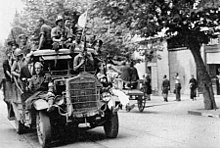

In the first major act of resistance following the German occupation, Italian partisans and local resistance fighters liberated the city ofNaplesthrough a chaotic popular rebellion.Naples was the first of the major European cities to rise up against the German occupation, and successfully at that.[39]The people of Naples revolted and held strong against Nazi occupiers in the last days of September 1943. The popular mass uprising and resistance in Naples against the occupying Nazi German forces, known as theFour days of Naples,consisted of four days of continuous open warfare and guerrilla actions by locals against the Nazi Germans. The spontaneous uprising of Neopolitan and Italian Resistance against German occupying forces (despite limited armament, organization, or planning) nevertheless successfully disrupted German plans to deport Neopolitans en masse, destroy the city, and prevent Allied forces from gaining a strategic foothold.
Elsewhere, the nascent movement began as independently operating groups were organized and led by previously outlawed political parties or by former officers of theRoyal Italian Army.Many partisan formations were initially founded by soldiers from disbanded units of theRoyal Italian Armythat had evaded capture inOperation Achse,and were led by junior Army officers who had decided to resist the German occupation; they were subsequently joined and re-organized by Anti-Fascists, and became thus increasingly politicized.[40]
Later theComitato di Liberazione Nazionale(Committee of National Liberation, or CLN), created by theItalian Communist Party,theItalian Socialist Party,thePartito d'Azione(arepublicanliberal socialistparty),Democrazia Cristianaand other minor parties, largely took control of the movement in accordance with KingVictor Emmanuel III's ministers and theAllies.The CLN was set up by partisans behind German lines and had the support of most groups in the region.[41]
The main CLN formations included three politically varied groups: the communistBrigate Garibaldi(Garibaldi Brigades), theGiustizia e Libertà(Justice and Freedom) Brigades related to the Partito d'Azione, and the socialistBrigate Matteotti(MatteottiBrigades). Smaller groups includedChristian democratsand, outside the CLN,monarchistssuch as theBrigate Fiamme Verdi(Green Flame Brigades) andFronte Militare Clandestino(Clandestine Military Front) headed by Colonel Montezemolo. Another sizeable partisan group, particularly strong in Piedmont (where theFourth Armyhad disintegrated in September 1943), were the "autonomous" (autonomi) partisans, largely composed of former soldiers with no substantial alignment to any anti-Fascist party; an example was the1° Gruppo Divisioni Alpineled byEnrico Martini.
Relations among the groups varied. For example, in 1945, the Garibaldi partisans underYugoslav Partisancommandattacked and killedseveral partisans of theCatholicandazionistaOsoppogroups in theprovince of Udine.Tensions between the Catholics and the Communists in the movement led to the foundation of theFiamme Verdias a separate formation.[42]
A further challenge to the 'national unity' embodied in the CLN came fromanarchistsas well as dissident-communist Resistance formations, such as Turin'sStella Rossamovement and theMovimento Comunista d'Italia(Rome's largest single anti-fascist force under Occupation), which sought a revolutionary outcome to the conflict and were thus unwilling to collaborate with 'bourgeois parties'.[43]
Partisan movement[edit]
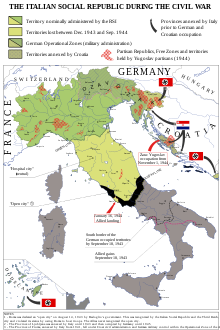
Rodolfo Grazianiestimated the partisan strength at around 70,000–80,000 by May 1944.[44]Some 41% in the Garibaldi Brigades and 29% were Actionists of theGiustizia e LibertàBrigades.[45]One of the strongest units, the 8th Garibaldi Brigade, had 8,050 men (450 without arms) and operated in theRomagnaarea.[44]The CLN mostly operated in theAlpinearea,Apenninearea andPo Valleyof theRSI,and also in the GermanOZAK(the area northeast of the north end of theAdriatic Sea) andOZAV(Trentino and South Tyrol) zones.[44]Its losses amounted to 16,000 killed, wounded or captured between September 1943 and May 1944.[44]On 15 June 1944, the General Staff of theEsercito Nazionale Repubblicanoestimated that the partisan forces amounted to some 82,000 men, of whom about 25,000 operated inPiedmont,14,200 inLiguria,16,000 in theJulian March,17,000 inTuscanyandEmilia-Romagna,5,600 inVeneto,and 5,000 inLombardy.[46]Their ranks were gradually increased by the influx of young men escaping the Italian Social Republic's draft, as well as from deserters from the RSI armed forces.[47]By August 1944, the number of partisans had grown to 100,000, and it escalated to more than 250,000 with the final insurrection in April 1945.[48]The Italian resistance suffered 50,000 fighters killed throughout the conflict.[49][50]
Partisan unit sizes varied, depending on logistics (such as the ability to arm, clothe and feed members) and the amount of local support. The basic unit was thesquadra(squad), with three or more squads (usually five) forming adistaccamento(detachment). Three or more detachments made abrigata(brigade), of which two or more made adivisione(division). In some places, several divisions formed agruppo divisione(divisional group). These divisional groups were responsible for azona d'operazione(operational group).
While the largest contingents operated in mountainous districts of the Alps and theApennine Mountains,other large formations fought in thePo Riverflatland. In the large towns of northern Italy, such asPiacenza,and the surrounding valleys near theGothic Line.Montechino Castlehoused a key partisan headquarters. TheGruppi di Azione Patriottica(GAP; "Patriotic Action Groups" ) commanded by the Resistance's youngest officer, Giuseppe "Beppe" Ruffino, carried out acts ofsabotageandguerrilla warfare,and theSquadre di Azione Patriottica(SAP; "Patriotic Action Squads" ) arrangedstrike actionsand propaganda campaigns. As in theFrench Resistance,women were often important members and couriers.[51]
Like their counterparts elsewhere in Europe, Italian partisans seized whatever arms they could find. The first weapons were brought by ex-soldiers fighting German occupiers from theRegio Esercitoinventory:Carcanorifles,Beretta M1934andM1935pistols,Bodeo M1889revolvers, SRCM and OTO hand grenades, andFiat–Revelli Modello 1935,Breda 30andBreda M37machine guns. Later, capturedK98ks,MG 34s,MG 42s,the iconicpotato-masher grenades,Lugers,andWalther P38swere added to partisan kits. Submachine guns (such as theMP 40) were initially scarce, and usually reserved for squad leaders.
Automatic weapons became more common as they were captured in combat and as the Social Republic regime soldiers began defecting, bringing their own guns.Beretta MABsbegan appearing in larger numbers in October 1943, when they were spirited awayen massefrom theBerettafactory which was producing them for the Wehrmacht. Additional weapons (chiefly of British origin) were airdropped by the Allies:PIATs,Lee–Enfieldrifles,Bren light machine gunsandSten guns.[52]U.S.-made weapons were provided on a smaller scale from theOffice of Strategic Services(OSS):Thompson submachine guns(both M1928 and M1),M3 submachine guns,United Defense M42s,and folding-stockM1 carbines.Other supplies included explosives, clothing, boots, food rations, and money (used to buy weapons or to compensate civilians for confiscations).
Countryside[edit]
The worst conditions and fighting took place in mountainous regions. Resources were scarce and living conditions were terrible. Due to limited supplies, the resistance adoptedguerrilla warfare.This involved groups of 40–50 fighters ambushing and harassing the Nazis and their allies. The size of the brigades was reflective of the resources available to the partisans. Resource limits could not support large groups in one area. Mobility was key to their success. Their terrain knowledge enabled narrow escapes in small groups when nearly surrounded by the Germans. The partisans had no permanent headquarters or bases, making them difficult to destroy.[53]
The resistance fighters themselves relied heavily on the local populace for support and supplies. They would often barter or just ask for food, blankets and medicine. When the partisans took supplies from families, they would often hand outpromissory notesthat the peasants could convert after the war for money. The partisans slept in abandoned farms and farmhouses. One account from Paolino 'Andrea' Ranieri (apolitical commissarat the time) described fighters using donkeys to move equipment at night while during the day the peasants used them in the fields. The Nazis tried to split the populace from the resistance by adopting areprisalpolicy of killing 10 Italians for every German killed by the Partisans. Those executed would come from the village near where an attack took place and sometimes from captive partisan fighters.
The German punishments backfired and instead strengthened the relationship. Because most resistance fighters were peasants, local populations felt a need to provide for their own. One of the larger engagements was the battle forMonte Battaglia(lit. "Battle Mountain" ), amountaintopthat was a part of the Gothic Line. On September 26, 1944, a joint force of 250 Partisans and three companies of U.S. soldiers from the88th Infantry Divisionattacked the hill occupied by elements of the German 290th Grenadier Regiment. The Germans were caught completely by surprise. The attackers captured the hill and held it for five days against reinforced German units, securing a path for the Allied advance.
Urban areas[edit]
Resistance activities were different in the cities. Some Italians ignored the struggle, while others organized, such as the Patriotic Action Squads and issued propaganda. Groups such as the Patriotic Action Groups carried out military actions. A more expansive support network was devised than in the countryside. Networks ofsafe houseswere established to hide weapons and wounded fighters. Only sympathizers were involved, because compulsion was thought to encourage betrayal. People largely supported the resistance because of economic hardships, especially inflation.Pastaprices tripled and bread prices had quintupled since 1938; hunger unified the underground and general population.[53]
Female partisans[edit]

Women played a large role. After the war, about 35,000 Italian women were recognised as femalepartigiane combattenti(partisan combatants) and 20,000 aspatriote(patriots); they broke into these groups based on their activities. The majority were between 20 and 29. They were generally kept separate from male partisans. Few were attached to brigades and were even rarer in mountain brigades. Female countryside volunteers were generally rejected. Women still served in large numbers and had significant influence.[54]
The groups were formed collaboratively by women from diverse political backgrounds. Prominent participants included communists Giovanna Barcellona,Lina Fibbi,Marisa Diena,and Caterina Picolato; socialistsLaura ContiandLina Merlin;actionists Elena Dreher andAda Gobetti;as well as women associated with theGiustizia e Libertà(Justice and Freedom) movement. Republican and Catholic women, along with those without prior political or ideological commitments, also joined. These groups predominantly operated in the northern midlands of Italy. Scholars attribute this geographic spread to the influence of local women's clothing, which fostered individual initiative and civic awareness.[55]
Initially, the women's groups aimed to support resistance efforts in auxiliary roles.[56]However, they quickly assumed leadership responsibilities in areas such as information dissemination, propaganda, issuing orders, and handling ammunition. Some women even directly engaged in armed resistance as "gappistas".[56][57]Ada Gobettiwas among the first to criticize the use of the term "assistance" in the group's name.[58]In 1944, the organization's objectives were reformulated to prioritize activities that broadly promoted women's emancipation.[59]
1944 uprising[edit]
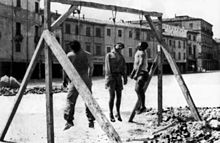
During the summer and early fall of 1944, with Allied forces nearby, partisans attacked behind German lines, led by CLNAI. This rebellion led toprovisionalpartisan governments throughout the mountainous regions.Ossolawas the most important of these, receiving recognition from Switzerland and Allied consulates there. An intelligence officer told Field MarshalAlbert Kesselring,Germany's commander of occupation forces in Italy, that he estimated German casualties fighting partisans in the summer of 1944 amounted to 30,000 to 35,000, including 5,000 confirmed killed.[60]Kesselring considered the number to be exaggerated, and offered his own figure of 20,000: 5,000 killed, between 7,000 and 8,000 missing / "kidnapped" (including deserters), and a similar number seriously wounded. Both sources agreed that partisan losses were less.[61]By the end of the year, German reinforcements and Mussolini's remaining forces crushed the uprising.
In their attempts to suppress the resistance, German and Italian Fascist forces (especially the SS,Gestapo,and paramilitary militias such asXª MASandBlack Brigades) committed war crimes, includingsummary executionsand systematic reprisals against the civilian population. Resistance captives and suspects were often tortured and raped. Some of the most notorious mass atrocities included theArdeatine massacre(335 Jewish civilians and political prisoners executed without a trial in a reprisal operation after a resistance bombattackin Rome), theSant'Anna di Stazzema massacre(about 560 random villagers brutally killed in an anti-partisan operation in the central mountains), theMarzabotto massacre(about 770 civilians killed in similar circumstances), theOssolamassacre (24 partisans murdered during their retreat fromCroveoto Switzerland) and theSalussola massacre(20 partisans murdered after being tortured, as a reprisal). In all, an estimated 15,000 Italian civilians were deliberately killed, including many women and children.[62]
-
A woman executed by public hanging in a street ofRome,early 1944
-
German soldier examining the papers of an Italian civilian outside ofMilan(1944)
-
TheSant'Anna di Stazzema massacrememorial relief
-
Memorial stone inSoragnafor two Italian partisans – killed in 1944
Civil war[edit]
Although other European countries such asNorway,theNetherlands,andFrancealso had partisan movements andcollaborationistgovernments withNazi Germany,armed confrontation between compatriots was more intense in Italy, making the Italian case unique.[63]In 1965, the definition of "civil war" was used for the first time by fascist politician and historianGiorgio Pisanòin his books,[64][65]whileClaudio Pavone's bookUna guerra civile. Saggio storico sulla moralità della Resistenza(A Civil War. Historical Essay On the Morality Of the Resistance), published in 1991, led to the term "Italian Civil War"being used more frequently by Italian and international[66][67]historiography.
Foreign contribution[edit]

Not all resistance members were Italians; many foreigners had escapedPOWcamps or joined guerrilla bands as so-called "military missions". Among them were Yugoslavs, Czechs (deserters from theProtectorate of Bohemia and Moraviaarmy, in Italy for guard/patrol duty in 1944), Russians, Ukrainians, Dutch, Spaniards, Greeks, Poles, German defectors and deserters disillusioned withNazism[68]and Britons and Americans (ex-prisoners or advisors deployed by the SAS,SOEandOSS). Some later became well-known, such as climber and explorerBill Tilman,reporter and historianPeter Tompkins,formerRAFpilotCount Manfred Beckett Czernin,and architectOliver Churchill.George Dunningrecorded his experiences of fighting with the partisans in his book "Where bleed the many".[69]
Aid networks[edit]
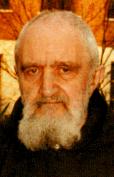
Another task carried out by the resistance was assisting escaping POWs (an estimated 80,000 were interned in Italy until 8 September 1943),[70]to reach Allied lines or Switzerland on paths previously used by smugglers. Some fugitives and groups of fugitives hid in safe houses, usually arranged by women (less likely to arouse suspicion). After the war, Field MarshalHarold Alexanderissued a certificate to those who thereby risked their lives.
Italian Jewswere aided byDELASEM,a network extending throughout occupied Italy that included Jews and Gentiles,Roman Catholicclergy, faithful/sympathetic police officers and even some German soldiers. DELASEM operated in Rome until the liberation under the leadership of the Jewish delegates Septimius Sorani, Giuseppe Levi, and theCapuchinFatherMaria Benedetto.Since Jews were considered "enemy aliens" by the Social Republic regime, they were left with little or nothing to live on, and many were deported to Nazi concentration and extermination camps where about 7,000 died. DELASEM helped thousands of Jews by offering food, shelter and money. Some of its members would later be designatedRighteous Among the Nations.
Liberation[edit]
1945 uprising[edit]


On 19 April 1945, the CLN called for an insurrection (the April 25 uprising). InBologna,the occupying Nazi German forces and their few remaining Italian Fascist allies were openly attacked by Italian partisans on 19 April, and by 21 April, the city of Bologna was liberated by the partisans, theItalian Co-Belligerent Army,and thePolish II Corpsunder Allied command;ParmaandReggio Emiliawere later freed on 24 April by the Italian Resistance and then the advancing Allied forces.TurinandMilanwere liberated on 25 April through a popular revolt and Italian Resistance insurrection following ageneral strikethat commenced two days earlier; over 14,000 German and Fascist troops were captured inGenoaon 26–27 April, when General Günther Meinhold surrendered to the CLN.[71]The forces of German occupation in Italy officially capitulated on 2 May. Fascists attempted to continue fighting, but were quickly suppressed by the partisans and the Allied forces.
The April insurrection brought to the fore issues between the resistance and the Allies.[72]Given the revolutionary dimension of the insurrection in the industrial centres of Turin, Milan, and Genoa, where concerted factory occupations by armed workers had occurred, the Allied commanders sought to impose control as soon as they took the place of the retreating Germans. While the Kingdom of Italy was the de facto ruler of the south, the National Liberation Committee, still embedded in German territory, existed as a populist organization which posed a threat to the monarchy and property owners in post-war Italy. However thePCI,under directives from Moscow, enabled the Allies to carry out their program of disarming the partisans and discouraged any revolutionary attempt at changing the social system. Instead, thePCIemphasized national unity and "progressive democracy" in order to stake their claim in the post-war political situation. Despite the pressing need to resolve social issues which persisted after the fall of fascism, the resistance movement was subordinated to the interests of Allied leaders in order to maintain the status quo.[72]
Revenge killings[edit]

A score-settling campaign (Italian:resa dei conti)[74]ensued against pro-German collaborators, thousands of whom were rounded up by the vengeful partisans. Controversially, many of those detainees were speedilycourt martialed,condemned and shot, or killed without trial. Minister of InteriorMario Scelbalater put the number of the victims of such executions at 732, but other estimates were much higher. Partisan leaderFerruccio Parri,who briefly served as Prime Minister after the war in 1945, said thousands were killed.[75]Some partisans, such as perpetrators of theSchio massacre,were tried by an Allied Military Court.[74]
During the waning hours of the war, Mussolini, accompanied by Marshal Graziani, headed to Milan to meet with CardinalAlfredo Ildefonso Schuster.Mussolini was hoping to negotiate a deal but was given only the option ofunconditional surrender.His negotiations were an act of betrayal against the Germans. When confronted about this by Achille Marazza, Mussolini said, "They [the Nazis] have always treated us as slaves. I will now resume my freedom of action." With the city already held by resistance fighters, Mussolini used his connections one last time to secure passage with an escaping German convoy on its way to theBrenner Passwith his mistressClaretta Petacci.[53]
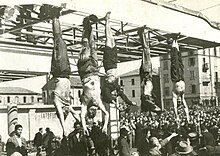
On the morning of 27 April 1945, Umberto Lazzaro (nom de guerre'Partisan Bill'), a partisan with the 52nd Garibaldi Brigade, was checking a column of lorries carrying retreating SS troops atDongo, Lombardy,near the Swiss border. Lazzaro recognized and arrested Mussolini. The task of executing Mussolini was, according to the official version, given to a 'Colonel Valerio' (identified asWalter Audisio) and the bodies of Mussolini and Petacci were later brought to Milan and hung upside down in thePiazzale Loretosquare. Eighteen executed prominent Fascists (including Mussolini,Fernando Mezzasoma,Luigi Gatti,Alessandro PavoliniandAchille Starace) were displayed in the square; this place was significant because the bodies of 15 executed enemies of Mussolini's regime had been displayed in this square the previous year.
The total number of victims of the anti-fascist movement remains unclear; it is estimated that between 12,000 and 26,000 people were killed, usually in extrajudicial executions. The outburst was particularly violent in the northern provinces; according to statistics provided by the Ministry of Interior, some 9,000 people were killed there during April and May 1945 only. Proportionally, the scale of vengeance killings was much greater than in Belgium and significantly above that recorded in France.[76]
Some historians who have dealt with the civil war in Italy have also taken into consideration the phenomenon of post-war violence, placing the end of the civil war beyond the official end of the Second World War in Europe. Therefore, for them, it is not easy to identify a real end date of the phenomenon, which slowly faded away. Some have proposed theTogliatti amnestyof 22 June 1946 as the end of the civil war.[77]
Casualties[edit]
According to a book published in 1955 by an Italian ministerial committee on the tenth anniversary of the Liberation, casualties in Italy among the Resistance movement amounted to 35,828 partisans killed in action or executed, and 21,168 partisans mutilated or left disabled by their wounds.[47]Another 32,000 Italian partisans had been killed abroad (in the Balkans and, to a lesser extent, in France).[47]9,980 Italian civilians had been killed in reprisals by the German and Fascist forces.[47]In 2010, theUfficio dell'Albo d'Oroof the Italian Ministry of Defence recorded 15,197 partisans killed; however, theUfficio dell'Albo d'Oroonly considered as partisans the members of the Resistance who were civilians before joining the partisans, whereas partisans who were formerly members of the Italian Armed Forces (more than half those killed) were considered as members of their armed force of origin.[78]
Liberation Day[edit]


Since 1946, 25 April has been officially celebrated asLiberation Day,also known as the Anniversary of the Resistance. It is a national holiday that commemorates the victory of the Italian resistance movement againstNazi Germanyand theItalian Social Republic,puppet stateof the Nazis andrump stateof the fascists, during theliberation of Italyand theItalian Civil WarduringWorld War II.The date was chosen by convention, as it was the day of the year 1945 when theNational Liberation Committeeof Upper Italy (CLNAI) – whose command was based in Milan and was chaired byAlfredo Pizzoni,Luigi Longo,Emilio Sereni,Sandro Pertini,andLeo Valiani(present among others the designated presidentRodolfo Morandi,Giustino Arpesani,andAchille Marazza) – proclaimed a general insurrection in all the territories still occupied by the Nazi-fascists, indicating to all the partisan forces active in Northern Italy that were part of the Volunteer Corps of Freedom to attack the fascist and German garrisons by imposing the surrender, days before the arrival of the Allied troops. "Surrender or die!" was the rallying call of the partisans that day and those immediately following.
Since then, public events in memory of the event, like marches and parades, have been organized annually in all Italian cities – especially in those decorated with military valour for the war of liberation. Among the events of the festival program, there is the solemn homage, by thePresident of Italyand otherimportant officers of the State,to the chapel of theItalian Unknown Soldier(Milite Ignoto), buried in theAltare della PatriainRome,with the deposition of alaurel wreathin memory of the fallen and missing Italians in wars.[79]Speaking at the 2014 anniversary, PresidentGiorgio Napolitanosaid: "The values and merits of the Resistance, from the Partisan movement and the soldiers who sided with the fight for liberation to the Italian armed forces, are indelible and beyond any rhetoric of mythicization or any biased denigration. The Resistance, the commitment to reconquer Italy's liberty and independence, was a great civil engine of ideals, but above all, it was a people in arms, a courageous mobilization of young and very young citizens who rebelled against foreign power."[80]
Aftermath[edit]
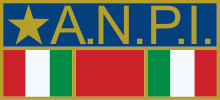
Today'sItalian constitutionis the result of the work of theConstituent Assembly,which was formed by the representatives of all the anti-nazist andanti-fascistforces that contributed to the defeat of Nazi and Fascist forces during the Italian resistance and theLiberation of Italy.[81]
Associazione Nazionale Partigiani d'Italia(ANPI; "National Association of ItalianPartisans") is an association founded by participants of the Italian resistance against theNazioccupation and the fascist and collaborationistItalian Social Republicduring the latter phase ofWorld War II.ANPI was founded inRomein 1944[82]while the war continued innorthern Italy.It was constituted as acharitable foundationon 5 April 1945. It persists due to the activity of its antifascist members. ANPI's objectives are the maintenance of the historical role of the partisan war by means of research and the collection of personal stories. Its goals are a continued defence againsthistorical revisionismand the ideal and ethical support of the high values of freedom and democracy expressed in the 1948constitution,in which the ideals of the Italian resistance were collected.[83]Since 2008, every two years ANPI organizes its national festival. During the event, meetings, debates, and musical concerts that focus on antifascism, peace, and democracy are organized.[84]
Bella ciao(Italian pronunciation:[ˈbɛllaˈtʃaːo];"Goodbye beautiful" ) is anItalian folk songmodified and adopted as an anthem of the Italian resistance movement by the partisans who opposednazismandfascism,and fought against the invading and occupying forces ofNazi Germany,who were allied with the fascist and collaborationistItalian Social Republicbetween 1943 and 1945 during the Liberation of Italy from German occupation and during the civil war. Versions of this song continue to be sung worldwide as a hymn of freedom and resistance.[85]As an internationally known hymn of freedom, it was intoned at many historic and revolutionary events. The song originally aligned itself with Italian partisans fighting against Nazi German occupation troops, but has since become to merely stand for the inherent rights of all people to be liberated from tyranny.[86][87]
See also[edit]
| History ofItaly |
|---|
 |
|
|
- Italian partisan brigades,a list of Italian resistance units
- Anti-fascism
- ANPI,an association of the participants to the Italian resistance
- Volante Rossa,an Italian communist antifascist militia active after WWII
- People's Squads,an Italian left-wing antifascist militia active during the early 1920s
- Lucetti Battalion,an Italian anarchist partisan brigade
- "Bella Ciao",the anthem of the anti-nazist and anti-fascist resistance
- Mazzini Society,formed by expatriate Italian anti-Fascists in the United States
- Anni di piombo
- Anarchism in Italy
- German resistance to Nazism
- Japanese dissidence during the Showa period
- Museum of the Liberation of Rome
In works of popular culture[edit]
- The Abandoned
- Achtung! Banditi!
- Bebo's Girl
- Beneath a Scarlet Sky
- Blood of the Losers
- Captain Corelli's Mandolin
- Cloak and Dagger
- Cloak & Dagger
- A Day for Lionhearts
- A Day in Life
- The Dirty Dozen: The Deadly Mission
- Escape by Night
- Everybody Go Home
- The Fall of Italy
- 1900
- The Fallen
- The Fascist
- The Four Days of Naples
- From the Clouds to the Resistance
- Gangsters
- General della Rovere
- Harmony in Ultraviolet
- His Day of Glory
- Hornets' Nest
- La buona battaglia – Don Pietro Pappagallo
- The Hunchback of Rome
- Johnny the Partisan
- Last Days of Mussolini
- Little Teachers
- Long Night in 1943
- The Man Who Will Come
- Massacre in Rome
- The Mattei Affair
- Miracle at St. Anna
- Paisan
- The Path to the Nest of Spiders
- Porzûs
- Rome, Open City
- Tea with Mussolini
- The Seven Cervi Brothers
- The Sun Still Rises
- Ten Italians for One German
- Two Anonymous Letters
- Wild Blood
References[edit]
- ^G. Bianchi,La Resistenza,in: AA.VV.,Storia d'Italia,vol. 8, pp. 368–369.
- ^Pavone 2006,pp. 256–257.
- ^Charles F. Delzell, edit.,Mediterranean Fascism 1919–1945,New York: Walker and Company, 1971, p. 26
- ^"Working Class Defence Organization, Anti-Fascist Resistance and the Arditi Del Popolo in Turin, 1919–22"(PDF).Archived(PDF)from the original on 19 March 2022.Retrieved23 September2021.
- ^Working Class Defence Organization, Anti-Fascist Resistance and the Arditi Del Popolo in Turin, 1919–22Archived19 March 2022 at theWayback Machine,Antonio Sonnessa, in theEuropean History Quarterly,Vol. 33, No. 2, 183–218 (2003)
- ^"Anarchist Century".Anarchist_century.tripod.com.Retrieved7 April2014.
- ^Bruscino, Felicia (25 November 2017)."Il Popolo del 1925 col manifesto antifascista: ritrovata l'unica copia".Ultima Voce(in Italian).Retrieved23 March2022.
- ^James Martin, 'Piero Gobetti's Agonistic Liberalism',History of European Ideas,32,(2006), pp. 205–222.
- ^Colombo 1979,pp. 332–338.
- ^Pugliese, Stanislao G.; Pugliese, Stanislao (2004).Fascism, Anti-fascism, and the Resistance in Italy: 1919 to the Present.Rowman & Littlefield. p. 10.ISBN978-0-7425-3123-9.Retrieved11 June2020.
- ^Tollardo, Elisabetta (2016).Fascist Italy and the League of Nations, 1922–1935.Springer. p. 152.ISBN978-1-349-95028-7.
- ^Scala, Spencer M. Di (1988).Renewing Italian Socialism: Nenni to Craxi.Oxford University Press. pp. 6–8.ISBN978-0-19-536396-8.Retrieved11 June2020.
- ^abJames D. Wilkinson (1981).The Intellectual Resistance Movement in Europe.Harvard University Press. p. 224.
- ^Stanislao G. Pugliese (1999).Carlo Rosselli: socialist heretic and antifascist exile.Harvard University Press. p. 51.
- ^Pavone 2006,p. 307.
- ^Colombo 1979,pp. 338–339.
- ^"Oggi in Spagna, domani in Italia".Archived fromthe originalon 27 December 2012.Retrieved28 May2020.
- ^"Oggi in Spagna, domani in Italia"(in Italian).Retrieved12 May2023.
- ^"L'8 settembre 1943"(in Italian).Retrieved20 September2023.
- ^"8 settembre 1943: l'armistizio che divise l'Italia e portò alla guerra civile"(in Italian).Retrieved20 September2023.
- ^Sanna, Daniele (2005).Da Porta San Paolo a Salò. Gioacchino Solinas comandante antitedesco.AM&D.ISBN88-86799-86-1.
- ^abcdefgh"Nell'anniversario della battaglia di Piombino, uno storico racconta perché la città merita l'onorificenza La medaglia d'oro, dopo 55 anni" Il massimo riconoscimento va concesso per ristabilire la verità "– Il Tirreno".Archived fromthe originalon 17 February 2020.Retrieved25 April2017.
- ^abcdefg"Piombino città di eroi – la Repubblica.it".8 October 2000.Retrieved25 April2017.
- ^abcde"8 settembre '43: la breve illusione di pace".September 2003.Retrieved25 April2017.
- ^"Interventi del Presidente – La Camera dei Deputati".Retrieved25 April2017.
- ^"FR L'Iphigénie of the French Navy - French Torpedo boat of the La Melpoméne class - Allied Warships of WWII - uboat.net".Retrieved25 April2017.
- ^"Seekrieg 1943, September".Retrieved25 April2017.
- ^abc"Penische fates".Retrieved25 April2017.
- ^"Wrecksite – Carbet".Retrieved25 April2017.
- ^"-La Nazione – Piombino – Taglio del nastro per la banchina" Giorgio Perini "".26 July 2012. Archived fromthe originalon 30 June 2017.Retrieved25 April2017.
- ^"Marinai d'Italia"(PDF).Retrieved25 April2017.
- ^"De Vecchi, Cesare Maria in" Dizionario Biografico "".Retrieved25 April2017.
- ^Vespa, Bruno (2010).Il cuore e la spada(in Italian). Mondadori. p. 261.ISBN978-8852017285.
- ^"Cefalonia. Ciampi:" Qui cominciò la Resistenza "".rainews24.rai.it(in Italian).Retrieved23 April2010.[permanent dead link]
- ^Natta, Alessandro (1997).L'altra Resistenza. I militari italiani internati in Germania.Einaudi.ISBN978-8806143145.
- ^"The Forgotten Italian Military Internees of WWII | the Stillman Exchange".Archived fromthe originalon 17 June 2018.Retrieved14 April2018.
- ^"Home".
- ^Gerlach, Christian(2016).The Extermination of the European Jews.Cambridge University Press.pp. 235–236.ISBN978-0-521-70689-6.
- ^"Senato.it – Resoconto sommario della seduta del 7 marzo 1946, pag.336"(PDF).Archived fromthe original(PDF)on 8 April 2014.
- ^Giuseppe Fioravanzo,La Marina dall'8 settembre 1943 alla fine del conflitto,p. 424.
- ^The Italian Army 1940–45 (3) Osprey Men-at-Arms 353ISBN978-1-85532-866-2
- ^Charles T. O'Reilly;Forgotten Battles: Italy's War of Liberation, 1943–1945;Lexington Books; 2001; p. 218
- ^Corvisieri, Silverio (1968).Bandiera Rossa nella Resistenza romana.Rome: Samona e Savelli.
- ^abcdMoseley, Roger (2004).Mussolini: The Last 600 Days of Il Duce.Taylor Trade Publishing.
{{cite book}}:CS1 maint: location missing publisher (link) - ^Longhi, Silvano (2010).Die Juden und der Widerstand gegen den Faschismus in Italien: 1943–1945.Berlin.
{{cite book}}:CS1 maint: location missing publisher (link) - ^Roberto Battaglia,Storia della Resistenza italiana,pp. 336–339.
- ^abcdGiuseppe Fioravanzo,La Marina dall'8 settembre 1943 alla fine del conflitto,p. 433.
- ^Capua, Giovanni Di (2005).Resistenzialismo versus Resistenza.Rubbettino Editore.ISBN9788849811971– via Google Books.
- ^"This Day in History – 9/6/1944 – Italian resistance fighters persevere".History.com. Archived fromthe originalon 20 October 2014.Retrieved30 December2013.
- ^“World War II: the Encyclopedia of the War Years, 1941–1945” p. 360
- ^"H-Net Review: Andrea Peto on Women and the Italian Resistance, 1943–45".H-Net.msu.edu. Archived fromthe originalon 6 December 2006.Retrieved30 December2013.
- ^Balbo, Adriano (2005).Quando inglesi arrivare noi tutti morti.Blu Edizioni.ISBN88-7904-001-4.
- ^abcBehan, Tom.The Italian Resistance: Fascists, Guerrillas and the Allies.London: Pluto, 2009. Print.
- ^Slaughter, Jane.Women and the Italian Resistance: 1943–1945.Denver, CO: Arden, 1997. Print.
- ^Marina Addis Saba, Partigiane. Tutte le donne della resistenza, Milan, Mursia Editore, 1998, pp. 40–50.ISBN88-425-2299-6.
- ^abMYmovies.it."Nome di battaglia donna".MYmovies.it(in Italian).Retrieved30 March2020.
- ^Gabriella Bonansea, Donne nella resistenza, in Enzo Collotti, Renato Sandri, Fediano Sessi (edited by), Dizionario della Resistenza, Turin, Einaudi, 2000, p. 272.
- ^Patrizia Gabrielli, Il 1946, le donne, la Repubblica, Rome, Donzelli, 2009, pp. 45–46.
- ^Franca Pieroni Bortolotti, Le donne della Resistenza antifascista e la questione femminile in Emilia (1943–45), in Donne e Resistenza in Emilia-Romagna, vol. 2, Milan, evangelist, p. 77.
- ^O'Reilly, Charles (2001).Forgotten Battles: Italy's War of Liberation, 1943–1945.Oxford.
{{cite book}}:CS1 maint: location missing publisher (link) - ^Italy's Sorrow: A Year of War, 1944–1945.New York: St. Martin's Press. 2008. p. 303.ISBN9781429945431.
- ^Gia Marie Amella."Hidden archive exposes WWII slaughters - CNN.com".Edition.cnn.com.Retrieved19 May2014.
- ^De Felice 1995,p. 22.
- ^"Storia della guerra civile in Italia"(PDF).
- ^See the books from Italian historianGiorgio PisanòStoria della guerra civile in Italia,1943–1945, 3 voll., Milano, FPE, 1965 and the bookL'Italia della guerra civile( "Italy of civil war" ), published in 1983 by the Italian writer and journalistIndro Montanellias the fifteen volume of theStoria d'Italia( "History of Italy" ) by the same author.
- ^See as examples theinterviewto French historianPierre Milzaon theCorriere della Seraof 14 July 2005 (in Italian) and thelessonsof historianThomas Schlemmerat the University of Munchen (in German).
- ^Payne 2011,p.202.
- ^Incerti, Matteo (2011).Il Bracciale di Sterline – Cento bastardi senza gloria. Una storia di guerra e passioni.Aliberti Editore.ISBN978-88-7424-766-0.
- ^Dunning, George (1955).Where bleed the many.London: Elek Books Limited.
- ^"British prisoners of the Second World War and the Korean War".The National Archives.Archived fromthe originalon 16 June 2013.Retrieved19 June2013.
- ^Basil Davidson,Special Operations Europe: Scenes from the Anti-Nazi War(1980), pp. 340/360
- ^abGinsborg, Paul (1990).A History of Contemporary Italy.Penguin Book. pp. 57–70.
- ^Lampredi, Aldo (20 April 2008)."Così fucilammo Mussolini e la Petacci"(PDF).Patria Indipendente(in Italian).Retrieved2 November2022.
- ^abFoot, John (2009)."The Resistance".Italy's Divided Memory.Palgrave Macmillan.pp. 176–179.ISBN978-0-230-10183-8.
- ^See theinterviewwith Ferruccio Parri, on "Corriere della Sera"15th November 1997. (in Italian)
- ^Keith Lowe,Savage continent,London 2012,ISBN9780241962220
- ^"Togliatti Guardasigilli, l'amnistia criticata del 1946"(in Italian).Retrieved14 February2022.
- ^http://www.campagnadirussia.info/wp-content/uploads/2011/12/I_caduti_del_fronte_orientale.pdfArchived2 August 2020 at theWayback Machine[bare URL PDF]
- ^Tobia, Bruno (2011).L'Altare della Patria(in Italian). Il Mulino. p. 109.ISBN978-88-15-23341-7.
- ^"Italy celebrates Liberation Day – Politics – ANSAMed.it".Ansamed.info. 4 June 1944. Archived fromthe originalon 2 April 2015.Retrieved19 May2014.
- ^McGaw Smyth, Howard (September 1948). "Italy: From Fascism to the Republic (1943–1946)".The Western Political Quarterly.1(3): 205–222.doi:10.2307/442274.JSTOR442274.
- ^"Chi Siamo".Website.ANPI.it. Archived fromthe originalon 2 May 2011.Retrieved14 April2011.
- ^"Riscoprire I Valori Della Resistenza Nella Costituzione"(in Italian).Retrieved22 October2022.
- ^"Festa dell'anpi".anpi.it. Archived fromthe originalon 24 May 2010.Retrieved22 October2022.
- ^"Bella ciao, significato e testo: perché la canzone della Resistenza non appartiene (solo) ai comunisti"(in Italian). 13 September 2022.Retrieved21 October2022.
- ^"ATENE – Comizio di chiusura di Alexis Tsipras".Archived fromthe originalon 20 April 2020.Retrieved23 January2015.
- ^"Non solo Tsipras:" Bella ciao "cantata in tutte le lingue del mondo Guarda il video – Corriere TV"[Not only Tsipras: "Bella ciao" sung in all languages of the world Watch the video – Corriere TV].video.corriere.it(in Italian).
Bibliography[edit]
- Colombo, Arturo (1979).Partiti e ideologie del movimento antifascista in: Storia d'Italia, vol. 8(in Italian). De Agostini.[ISBN unspecified]
- De Felice, Renzo (1995).Rosso e Nero[Red and Black] (in Italian). Baldini & Castoldi.ISBN88-85987-95-8.
- Pavone, Claudio(2006).A Civil War(in Italian). Bollati Boringhieri.ISBN978-88-339-1676-7.
- Payne, Stanley G. (2011).Civil War in Europe, 1905–1949.Cambridge University Press.ISBN9781139499644.
External links[edit]
- Italy | European Resistance Archive
- (in Italian)ANPI – Associazione Nazionale Partigiani d'Italia
- (in Italian)ANCFARGL – Associazione Nazionale Combattenti Forze Armate Regolari Guerra di Liberazione
- (in Italian)INSMLI – Istituto Nazionale per la Storia del Movimento di Liberazione in Italia
- (in Italian)Il portale della guerra di Liberazione
- Anarchist partisans in the Italian Resistance








